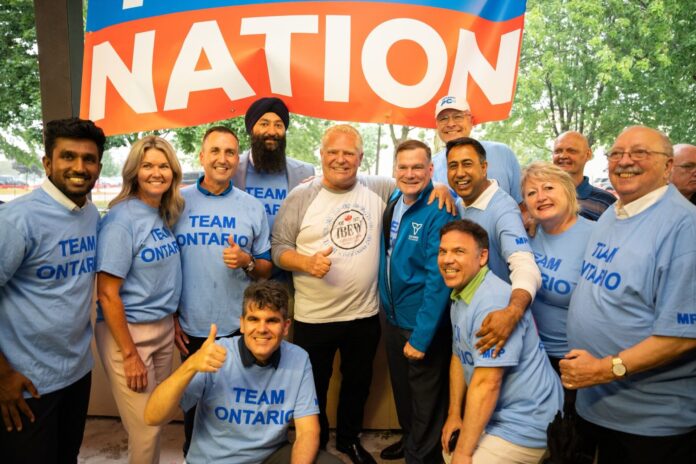
Heather Wright/The Independent
Sarnia-Lambton MPP Bob Bailey is backing Premier Doug Ford’s decision to allow 3,000 hectares of prime farm land in the Greenbelt to be developed.
And he’s downplaying the amount of prime agricultural land which will be lost as the province allows developers to build homes on the previously protected land despite calls from the province’s auditor general to protect them once more.
In 2005, The Greenbelt was created to protect some two million acres of unique habitats, wetlands and some of the best farmland in Ontario from being enveloped into the GTA for housing and industry. In Nov. 2022, the province announced it would be removing 3,000 hectares of the land out of the protected zone to allow the province to meet its goal of building 1.5 million homes in a decade.
But Auditor General Bonnie Lysyk found a handful of developers – donors to the Conservative Party – had the most to gain from the move – making an estimated $8.3 billion based on 2016 – as the value of the land exploded with the announcement.
Lysyk found the decision to allow development on the land took only three weeks and was spearheaded by a political appointee in the Minister of Housing’s office who had been appointed by Premier Ford.
“We found that how the land sites were selected was not transparent, fair, objective, or fully informed. She recounted how the appointee met with some of the developers who bought the land just before the provincial announcement. Lysyk says the developers had influence on what land was removed from the Greenbelt.
“About 92 per cent of the approximately 7,400 acres ultimately removed from the Greenbelt are five land sites put forward by two developers who had access to the Chief of Staff in September 2022.”
Lysyk called the process “seriously flawed” and informed the OPP and the Ontario Ombudsman of the irregularities she found.
The auditor general made 15 recommendations in her report, including returning the 3,000 hectares to the Greenbelt. That’s the only recommendation the premier won’t follow.
And Bailey says he backs the premier. “We need to build more housing; I certainly support the Premier on that,” Bailey told The Independent suggesting people may not understand the Greenbelt issue “unless you live around Toronto.”
The Premier has said the development of the Greenbelt is needed as the federal government rapidly increases immigration with many people settling in Toronto.
The Auditor General refutes that argument.
“It also can be shown that there was sufficient land for the target of 1.5 million homes to be built without the need to build on the Greenbelt,” Lysyk wrote.
“She’s entitled, to her own opinion, there’ll be other people’s who differ from hers,” said the Sarnia-Lambton MPP.
Bailey says while there have been concerns raised to his office staff, no one has talked to him about the auditor’s report.
One of the biggest opponents of the move was the Ontario Federation of Agriculture, which called for the “permanent protections from the threat of urban development” in a submission to the Environmental Registry of Ontario before the decision was made.
“When agricultural land is developed, it is lost forever. Ontario is losing some of its most productive agricultural land to pressures for urbanization and growth enabled by provincial policies and tools.”
But Bailey downplayed the concern saying “There’s land in there (the Greenbelt land in question) that’s not prime farmland” and “it’s less than one per cent of the two million acres (of protected lands) and we’re adding another 2,400 acres into the Greenbelt land.
“We need to remember too, this is all private land. It’s not government land. It’s not public land. This is private land, being developed by developers,” said
Bailey failing to address the fact it was a provincial decision which is making it possible for developers to start building on the once protected agricultural land.
“I think the farm community have gotten more innovative. They’re producing more food on even less land because of agricultural practices.”
Bailey says as he drives around Lambton he notes a lot of construction in farm areas particularly in Plympton-Wyoming as well. And he says the solar farm in Sarnia is also built on prime agricultural land.
“In my opinion, that should have never happened, but it’s there now. I don’t see that ever changing.”
The Independent asked Bailey if he’s concerned about the solar farm on agricultural land, why not housing in the Greenbelt?
“That’s where people want to live – in that area around Toronto,” Bailey said.
“If they’re going to live down there, we have to develop (it) for them to live on.”
Bailey adds if the developers don’t make significant progress on building housing by the end of 2023, the land will be returned to the Greenbelt.
Bailey says the Provincial Land Development Facilitator – what he said is a “non-political” appointed body – will decide whether significant progress has been made.
According to the government website The PLDF helps the province, municipalities, developers, businesses and community groups resolve issues related to growth management, land use and infrastructure planning, and environmental protection by providing impartial facilitation services or by acting as a negotiator on behalf of the province. Paula Dill has been the chair since 2015.




